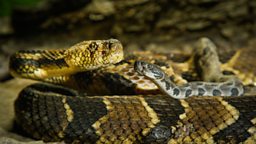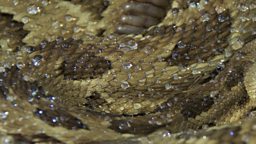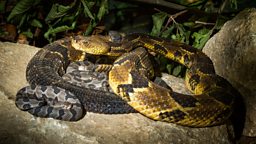Filming a rattlesnake birth
Paul Williams, producer
We had been successful at filming a rattlesnake hunting in the wild but I was keen to try and show both sides of this beautiful, and misunderstood animal. Timber rattlesnakes are one of the few snakes that give birth to live young and show parental care. This had never been filmed for TV before. The only way that we had a chance of filming this behaviour was to work with Dr. Lou Perrotti, head of conservation at Roger Williams Park Zoo. Here he heads up the rattlesnake conservation project.
After many years of heavy persecution, by the 1960s the Timber rattlesnake was almost extinct in New England, but now they are making a comeback with a few hundred living in these forests. Dr Anne Stengle, who helped us to film a rattlesnake hunting in the wild, has tagged a number of female snakes in a forest not far from Boston. Every summer she surveys the population to identify pregnant females. These are captured and temporarily relocated to Roger Williams Park Zoo where Lou and his team have built special enclosures for the snakes to safely give birth in. Here the young grow strong and healthy before they are released back into the wild, helping to repopulate the forest. This project has allowed the scientists to ensure the survival of many more babies than would naturally do so in the wild.
"Very few people in New England have seen a timber rattlesnake, and no one has seen the intimate side of their nature. Wild timber rattlesnakes typically birth under rocks, where it’s impossible to observe." - Anne Stengle
A few weeks before we arrived Anne located a pregnant female, nicknamed Rhonda, that she believed would give birth within our time frame. Before Rhonda was brought to the zoo we wanted to ensure that we had everything prepared, because like with any animal, giving birth is a very sensitive time in a snakes life and we wanted to reduce any stress. We needed to keep our impact and presence to a minimum, so that she would behave as if in the wild.
In the basement of the zoo we worked with Lou to build a heated enclosure made of rocks, and similar to the natural areas the snakes might use to give birth in the wild. We installed remotely operated low-light cameras so that we could keep illumination in the den to a minimum, and through an internet feed we could monitor and film the snakes without disturbing them. The camera could also be controlled by members of our team back in the UK, who watched the live feed and took shifts through the night. For a limited number of hours each day cameraman Michael Male worked from behind a blind, poking his camera lens through a small hole to film the snake as she settled into her birthing den.
A routine ultrasound scan showed that Rhonda was pregnant with 7 babies and although not certain, the scientists believed that they could be due within the next few days. Everything was prepared. Now all we needed to do was wait. But a few days turned into several weeks. Michael and myself in the US, and the rest of our team in the UK, watched and waited in anticipation. After three weeks, researcher Guthrie Freeman was sat in his bedroom in Bristol, UK. It was 3am and he was monitoring the live feed. He suddenly noticed a small head popping out from behind Rhonda and jumped to action. He hit record on the camera, that was sat in the basement of a zoo three thousand miles away, and captured a timber rattlesnake giving birth - the first time this has been filmed. He called Michael, myself and Lou in the US, and we all headed to the zoo, where the zoo director opened the gates. We were just in time to film the behaviour that we had all been hoping for - the intimate moments of parental care as Rhonda’s babies climb up, out of the birthing den to snuggle into the safety of their mothers coils. The first time this behaviour, of a New England rattlesnake, has been documented on film.
On seeing the behaviour Anne said - “This is truly unique and amazing footage, it's such a unique opportunity to see a crucial part of their lives. Much of the public still fear snakes and do not value protecting them, but they are a key species in our forests."
Dr Lou Perrotti said “The Roger Williams Park Zoo is proud to have worked with the 麻豆社 team to capture this rare footage of seldom seen Timber rattlesnake behaviour. This footage brings to light the tender side of an often misunderstood species. This film brings an educational message that can only help in the ongoing efforts to conserve this endangered New England native”



















